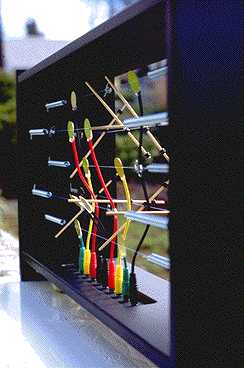Between Sound and Vision (hear installation sound)
at the Universty of Illinois at Chicago, Gallery 400
February 18 through March 10, 2001
by Fred Camper, Chicago Reader
- March 2, 2001
IN THE MOMENTS
Avant Garde artists are often
misrepresented in the popular press as nutcases or charlatans.
John Cage and his chance music have been derogated in "my
kid could do that" terms. Alan Kaprow's happenings were written
up as sensational, unstructured novelties meant to shock. The
Fluxus artists' attempts to blend art and life--Alison Knowles
ate an identical lunch for months, declaring the act of doing
so art@ould easily be presented as merely silly.
 But as the 53 works by 45 artists (another 10
contribute live or recorded performances) in "Between Sound
and Vision" at Gallery 400 reveal, such artists were making
work as thoughtfully considered as any old master, though their
ethos and approach couldn't be more different. While this magnificent,
enlightening, and just plain joyous exhibition concentrates on
artists who came of age in the 50s and 60s, pieces by some younger
and lesser known artists show that childlike utopianism has at
least a few heirs today.
But as the 53 works by 45 artists (another 10
contribute live or recorded performances) in "Between Sound
and Vision" at Gallery 400 reveal, such artists were making
work as thoughtfully considered as any old master, though their
ethos and approach couldn't be more different. While this magnificent,
enlightening, and just plain joyous exhibition concentrates on
artists who came of age in the 50s and 60s, pieces by some younger
and lesser known artists show that childlike utopianism has at
least a few heirs today.
The theme of the exhibit is
work that integrates sound and images, and most of the artists
chosen by the curators-University of Illinois art, history professor
Hannah Higgins and a group of her graduate students, who spent
two years putting together the show, partake of a similar aesthetic.
Key is the surrender of ordered perfection, and some degree of
artistic control, to chance operations, the decisions of the performers,
or both. Incorporating chance was not part of an attempt to épater
le bourgeois but resulted from what Cage called an intent
"to affirm this life ... not to bring order out of chaos
or suggest improvemcm so creation. but simply to wake up to the
very life we're living." These artists create real or metaphorical
frames that allow the viewer to focus, not so much obliterating
the distinction between art and life as encouraging the viewer
to have a deeper experience of life.
...
Yet it seems the routes mapped
out by Cage and the Fluxus artists in the 50s and 60s have largely
become roads not taken, as the art world has increasingly returned
to the manufacture and sale of objects. Two wonderful sound installations
seem to acknowledge this fact: lacking the physical and philosophical
scope of works by Kaprow and Cage, these pieces carve out a small
part of the gallery in which to make their music.
Dan
Senn ...
is represented by Vertical
'lyre I (1997).
Horizontal strands of fishing line and piano wire are strung across
a black frame, looking like musical staffs. The tension in the
fishing lines is changed by inaudible low-frequency sounds, causing
several thin rods attached to them to rotate and hit the piano
wires, whose sound is then amplified. The result is a gentle percussive
composition, accompanied by recorded music from a CD that also
produces the low-frequency sounds. The frame provides a visual
focus, and one quickly notices that the rods twist out of sync.
Senn pointed out to me that he's placed tiny weights on them in
different positions, resulting in a different center of gravity
for each.
The resulting
quiet mix of order and randomness makes one feel that this tiny
machine isn't working quite right and that's part of the point.
It's hard not to see Vertical 'lyre I in the context of larger
more sychronized sound-and-image projects, such as Nam June Paik's
giants banks of video monitors, which create a single image. Senn's
piece is far less dictratorial. He makes no pretense of reordering
the world; instead he directs the viewer toward the "lesser"
goal of aprreciating tiny sounds and small movementsthat don't
quite come together, because daily life is quite unlike a classical
symphony of military march.
Trimpin, a German native who
now lives in Seattle, offers ...
MAIN
INDEX
 But as the 53 works by 45 artists (another 10
contribute live or recorded performances) in "Between Sound
and Vision" at Gallery 400 reveal, such artists were making
work as thoughtfully considered as any old master, though their
ethos and approach couldn't be more different. While this magnificent,
enlightening, and just plain joyous exhibition concentrates on
artists who came of age in the 50s and 60s, pieces by some younger
and lesser known artists show that childlike utopianism has at
least a few heirs today.
But as the 53 works by 45 artists (another 10
contribute live or recorded performances) in "Between Sound
and Vision" at Gallery 400 reveal, such artists were making
work as thoughtfully considered as any old master, though their
ethos and approach couldn't be more different. While this magnificent,
enlightening, and just plain joyous exhibition concentrates on
artists who came of age in the 50s and 60s, pieces by some younger
and lesser known artists show that childlike utopianism has at
least a few heirs today.